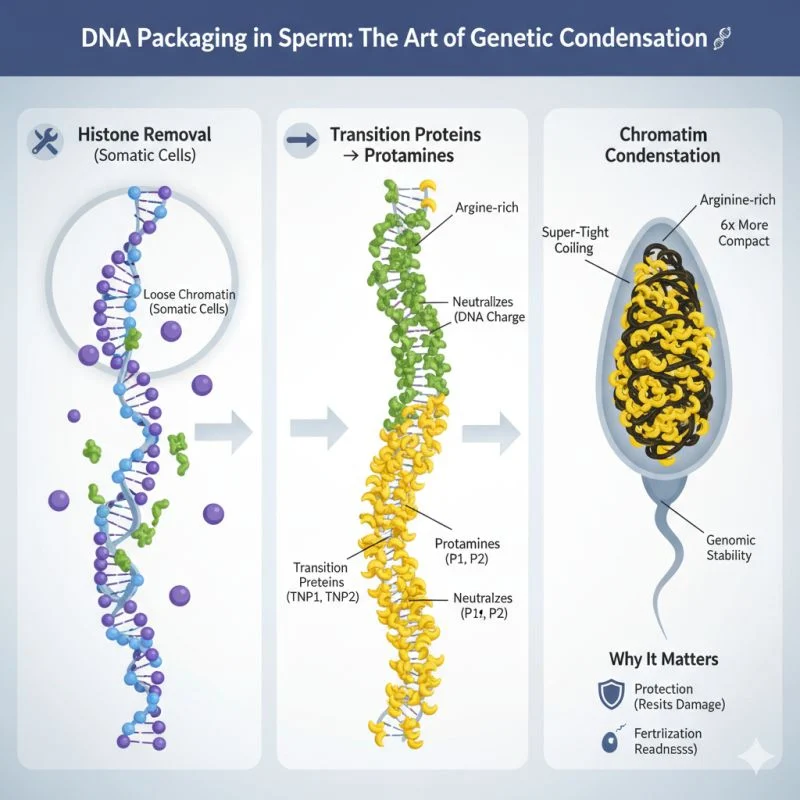
Rahul Manoj: DNA Packaging in Sperm
Rahul Manoj, Senior Embryologist at Best Life Fertility Center, shared a post on LinkedIn:
“Day 31 – DNA Packaging in Sperm: The Art of Genetic Condensation
One of the most remarkable transformations in spermatogenesis is how the sperm’s DNA becomes packed into an incredibly compact form – essential for protecting the paternal genome and ensuring fertilization success.
What Happens During DNA Packaging
During spermiogenesis, the round spermatid’s loose chromatin (similar to that in somatic cells) undergoes a dramatic reorganization:
1. Histone Removal:
In normal cells, DNA is wrapped around histones.
In sperm, these histones are gradually replaced by transition proteins (TNP1 and TNP2).
2. Transition Proteins → Protamines:
Transition proteins are then replaced by protamines (P1 and P2), which are small, arginine-rich proteins.
Protamines neutralize the negative charge of DNA and allow super-tight coiling of the genetic material.
3. Chromatin Condensation:
The resulting DNA-protamine complex is about six times more compact than somatic chromatin.
This extreme condensation ensures genomic stability during sperm transport and protects DNA from damage and mutagens.
Why It Matters
Protection: Highly compacted DNA resists oxidative and enzymatic damage.
Fertilization readiness: Proper DNA packaging ensures accurate delivery of the paternal genome to the oocyte.
Infertility Link
Incomplete protamination leads to loosely packed DNA, increased DNA fragmentation, and poor embryo development.
These issues can be assessed through chromatin structure assays (SCSA) or protamine deficiency tests such as CMA3 staining.
Clinical Value
An abnormal protamine ratio (P1:P2 imbalance) is associated with:
Poor sperm motility and morphology
Lower fertilization and pregnancy rates in assisted reproductive technologies (ART)
Improving antioxidant status and optimizing the testicular environment can enhance proper DNA packaging and overall sperm quality.”

Stay updated on all scientific advances in the field of fertility with Fertility News.
-
Oct 11, 2025, 06:44The Global IVF Market Is Set to Reach $65B by 2032 – Meddilink
-
Dec 21, 2025, 01:49CDC Releases 2024 Pregnancy Mortality Data – Preeclampsia Foundation
-
Dec 21, 2025, 01:30Caitlin Wyrwoll: New Insights on Maternal Health and Extreme Heat
-
Dec 20, 2025, 10:57Clare Pin-Chia Huang: New Research Links Maternal Diabetes to Pregnancy Risks
-
Dec 20, 2025, 10:53Evaluating Maternal and Neonatal Health in Rheumatoid Arthritis Pregnancies – Hiroki Ozawa
-
Dec 20, 2025, 10:36Enhancing Care for Women Facing Recurrent Pregnancy Loss – SOGC
-
Dec 20, 2025, 05:00Ilana Ferhadian: Celebrating Book Launch
-
Dec 19, 2025, 16:21Launch of National Fertility Plan Marks Public Health Milestone – Collectif BAMP Association
-
Dec 18, 2025, 13:55Insights from Cendrine Siraudin on Fertility Support – Destination Santé
-
Dec 18, 2025, 13:34Alberto Sifuentes Giraldo: Key Insights on Antiphospholipid Syndrome From Recent Study
